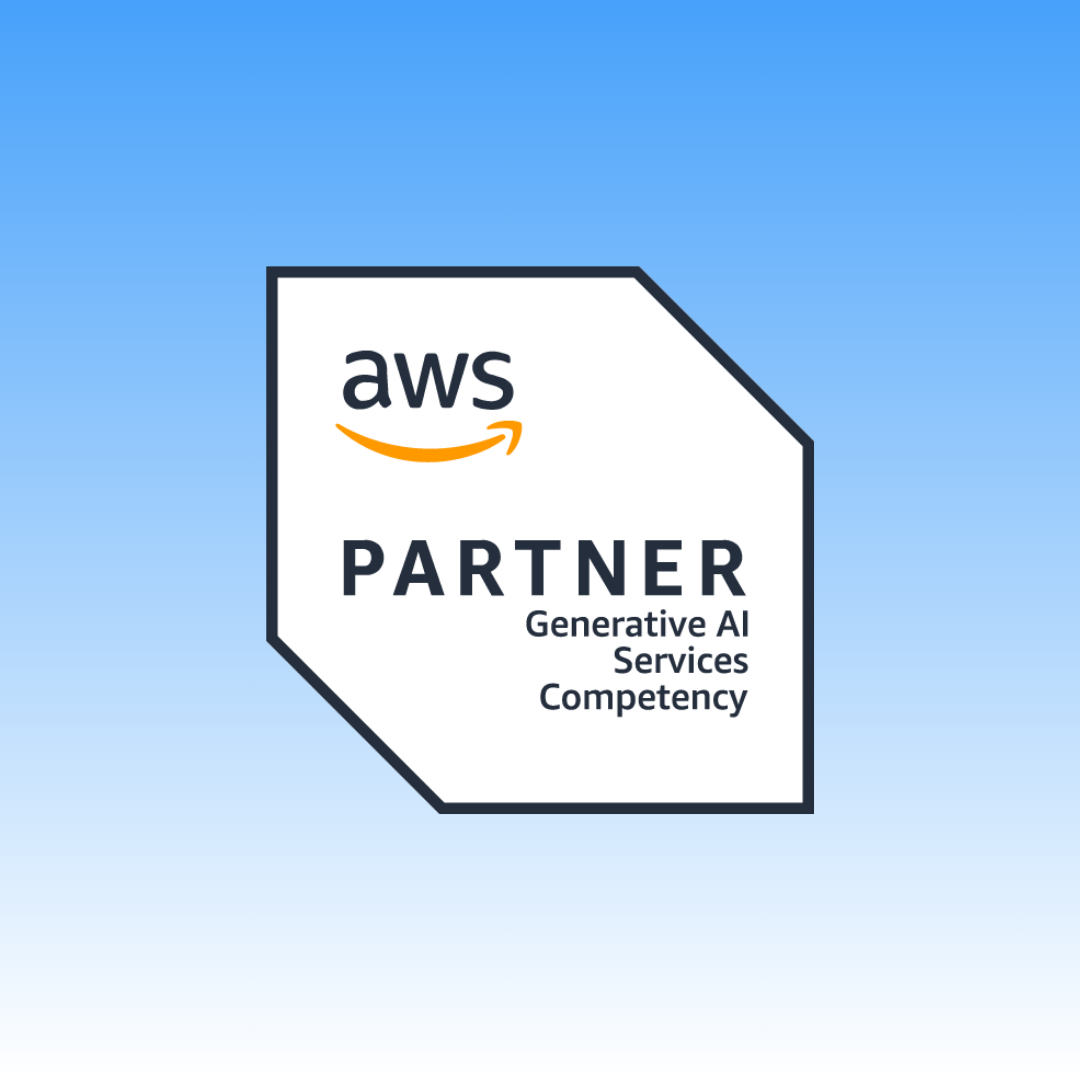PARTNER-EXCLUSIVE ACCESS
Accelerate Your Co-Selling with MissionHQ
Enter your work email to unlock ready-to-use sales playbooks, campaign kits, and demand-gen resources - all designed to help you close more deals, faster with Mission.
Generative AI Sales Playbook
Help customers see real ROI with generative AI on AWS
Vertical-Specific Sales Plays
Businesses are under growing pressure to incorporate generative AI solutions, but many lack the internal resources and expertise to develop them effectively. Beyond technical implementation, there's a crucial need to identify which applications will offer the highest return on investment.
That's where Mission comes into play. As an AWS Premier Tier Partner with a proven track record in AI expertise, we've successfully delivered over 100 unique generative AI projects.
In This Playbook You'll Learn...
- How Mission can lead your customers' generative AI projects and why we are the right gen AI partner
- Sales Plays for thirteen common gen AI use cases. Each sales play includes an ideal customer profile, common verticals, pitching techniques for each use case, a marketplace offer, email nurtures, and examples of customer success stories
- How to increase the likelihood of generative AI POCs transitioning to production and an outline of Mission’s process ensuring a smooth and successful transition


IDP Accelerator
- Business document processing
- Generative AI-intensive solution
- Ongoing data management and processing

Quicksight Migrations
- Migrating BI Tools to Amazon Quicksight
- Data & Analytics intensive solution
- Ongoing dashboard maintenance and development
%20(1).png?width=600&height=280&name=CloudHustle%20New%20Branding%20(600%20x%20280%20px)%20(1).png)
ML Model Builder
- Analyzing business data
- Machine Learning intensive solution
- Ongoing model CI/CD pipeline creation, monitoring, and management

ChatBot Builder
- Building conversational AI assistants
- Generative AI intensive solution
- Ongoing prompt optimization, data source integration, and performance tracking
-
Automotive & Manufacturing
- Concept-Specific Image Generation
- Large Scale Model Training
- Call Centers
- Knowledge Management/Chatbots
- Generative BI
- Recruiting
-
Travel & Hospitality
- Dubbing & Translation
- Concept-Specific Image Generation
- Marketing Personalization &
- Automation
- Call Centers
- Generative Business Intelligence
- Recruiting
-
Financial Services
- Intelligent Document Processing
- Marketing Personalization & Automation
- Generative Business Intelligence
- Recruiting
-
Retail & CPG
- Concept-Specific Image Generation
- Marketing Personalization & Automation
- Call Centers
- Knowledge Management/Chatbots
- Recruiting
-
ISV
- Intelligent Document Processing
- Knowledge Management/Chatbots
- Call Centers
- MLOps
- LLMOps
- Recruiting
-

TMEGS
- Dubbing & Translation
- Concept-Specific Image Generation
- Marketing Personalization & Automation
- Call Centers
- Recruiting
-

Telecom
- Knowledge Management/Chatbots
- Call Centers
- Marketing Personalization & Automation
- Recruiting
-
Healthcare & Life Sciences
- Intelligent Document Processing
- Drug Discovery
- Recruiting
-
Energy & Utilities
- LLMOps
- Recruiting

We have extensive expertise of generative AI, having developed over 70 unique solutions in 2024 across various use cases

Our DAML team is led by Dr. Ryan Ries, our Chief AI and Data Scientist, with over 20 years of experience working with AI

Mission is a highly trusted generative AI partner of AWS. Our gen AI customer story, MagellanTV, was featured during Ruba Borno’s keynote at re:Invent 2023

We were one of the few launch partners for the AWS Generative AI Competency
Industry-Specific Solutions
Common Challenges
-
.png?width=2000&height=2000&name=New%20Social%20Media%20-%20Emma%20(3).png)
Lack of Alignment with Organizational Objectives
Without a solid understanding of how the POC aligns with the organization's broader goals, it becomes difficult to justify investing resources into transitioning it to production.
-

Readiness of Data and Technology Maturity
Ensuring that the data is prepared and of high quality and that the technology is mature enough to support scalable deployment is crucial for a successful transition.
-

Leadership Alignment and Understanding of AI Benefits
Organizational leaders must grasp the potential benefits of AI and how it can drive value for the business. Securing the necessary resources and commitment to move the POC forward without leadership support and understanding becomes challenging.
-

Scarce Expertise in Emerging AI Technologies
Developing and deploying generative AI solutions require specialized skills and knowledge that may not be readily available within organizations. This scarcity of expertise can hinder the transition process and prolong the time it takes to move from POC to production.
Preparing for Success
To overcome the prior challenges and ensure a successful transition from generative AI Proof of Concepts (POCs) to production, thorough preparation is essential. Mission is utilizing the following key steps to prepare for a successful project.
In-Depth Evaluation of Skills, Budget, and Vision
Understanding the team's capabilities, resources, and project vision sets the foundation for effective planning and execution. This assessment identifies strengths, weaknesses, and limitations, helping stakeholders create a strategic roadmap that aligns with organizational goals for a smooth transition.
Aligning Leadership & Building AI Understanding
Leadership buy-in is essential for securing the resources and support needed for a successful transition. By educating leaders on what AI can realistically achieve, along with its limitations, you help manage expectations, foster more informed decision-making, and ultimately create a smoother path forward.
Collaboration
with Stakeholders
It is imperative to define success criteria and outline the next steps post-POC. Engaging stakeholders early on allows for alignment on goals and expectations, as well as the establishment of clear metrics for evaluating the success of the project. Involving stakeholders in the process makes it easier to garner support for the transition to production.
Post-POC: Transitioning from POC to Production

Testing & Evaluation
Transitioning from POCs to production in the realm of generative AI involves rigorous testing and evaluation against defined objectives. This step ensures that the POC meets the desired outcomes and aligns with organizational goals before moving forward.

Automation and Scalability Considerations
Considerations for automation and scalability are vital for production readiness. Implementing automation processes and ensuring scalability guarantees that the solution can handle increased workload demands efficiently.

Demonstration of Capability and Value
Demonstrating the capability and business value of the POC is imperative for gaining stakeholder buy-in. Providing tangible evidence of the solution's benefits, the potential for increased efficiency or cost savings, and how it aligns with organizational objectives strengthens the case for moving forward.

Cost-Benefit Analysis
Calculating costs and comparing benefits against alternative solutions is vital for decision-making. Conducting a comprehensive cost-benefit analysis helps the customer evaluate the economic viability of the AI solution compared to other available options.

Detailed Transition Plan
Finally, detailing a clear plan for transition from POC to production, including milestones and timelines, ensures a structured approach to deployment. Setting clear milestones and timelines helps track progress and ensures that the transition process stays on track towards successful production deployment.
%20(1).png?width=1000&height=1000&name=Untitled%20(1000%20x%201000%20px)%20(1).png)
Ready to get started?
Not sure who your account executive is? Contact:
- Nick Geraci, Channel Manager, SUP: ngeraci@missioncloud.com
- Audrey Reznikov, Channel Manager, SMB: areznikov@missioncloud.com
- Matt Forlow, Channel Manager, ENT: mforlow@missioncloud.com
- Stuart Klipp, Manager, Channels & Alliances: sklipp@missioncloud.com
Want to learn more about Mission?
MissionHQ is your go-to co-selling platform, packed with tailored resources across segments and verticals, designed to make co-selling with Mission easier than ever. Click below to go to your segment's dedicated MissionHQ hub to learn more.
Will I experience downtime during my AWS migration?
This depends on the specifics of the workloads you’re moving, the type of migration you’re doing, and your preferred timeline, but in general we will optimize your cloud migration services to ensure the minimal necessary downtime. Since this is often a concern, this is one of the first items we’ll address when constructing your migration plan and we’ll discuss strategies and mitigations we can employ to minimize the impact on your business.
How much experience does Mission Cloud have with cloud migrations?
Lots. Mission has migrated hundreds of customers to AWS, both from all the providers you’ve heard of and many you haven’t. We’ve been certified by AWS for migrations work with the Migrations Competency, and we are recognized by AWS as the #1 Partner at “recognized revenue” in its Migration Acceleration Program—that means getting workloads onto AWS rapidly and exactly as predicted in our migration plans.
What are the various cloud migration strategies?
- Rehost – Also commonly referred to as “lift-and-shift,” this strategy involves reproducing your current architecture as much as possible. This can be an ideal first phase for some cloud migrations, but is often the least efficient strategy in the long-term.
- Relocate – This strategy is most-common for inter-AWS migrations or replatforming to a cloud version of an application. This often means moving resources between accounts, VPCs, or regions and is common during acquisitions when a new account architecture is necessary.
- Replatform – This strategy takes advantage of AWS-managed services for your workloads, like moving a database to RDS, moving to AWS-specific hardware, like Graviton, or even modernizing OSes and moving to Linux to reduce licensing costs. Replatforming is a great option when you want to preserve a legacy application’s structure while reducing its operational overhead.
- Refactor – Also known as “Re-Architect,” this is about modernizing your applications as you move them to the cloud. Often there can be significant performance and cost wins for re-architecting some or even all of your workloads as part of a migration and engaging with this option is often ideal for cost of ownership.
How do I know which cloud migration strategy to choose?
The truth is, you won’t—not until you’ve accurately assessed your business and cost objectives. Some businesses think they will prefer a simple cloud migration that reproduces their current architecture but discover the inefficiencies aren’t acceptable. That’s why we make assessing your current state and business objectives a part of every engagement—to help you find the combination of optimization, timeline, and cost of ownership that best meets your needs.
How can I minimize downtime during a cloud migration?
This comes down to preparation, planning, and execution. Knowing what you’re attempting to migrate, what critical systems you need to have online, elements of your architecture that depend on a given service’s availability or consistency—all of these elements can create downtime if they’re not appropriately managed. We’ll work with you to identify these critical components of your system and come up with plans to mitigate the effects of a transition and make it as seamless as possible.
How long does a cloud migration take?
The real answer is: it depends on how complex the workload is and the cloud migration strategy. A lift and shift strategy, for example, can be faster than a refactor strategy—but it may also take more tuning and right-sizing to meet your performance and cost objectives. Some migrations take weeks. Some unfold over multiple phases while taking a year or more. But you won’t know the real answer without an accurate assessment of your current environment and objectives for AWS adoption.
.png?width=1203&height=241&name=MissionHQ%20Chiclet%20(1).png)
















.png?width=150&height=150&name=MissionHQ%20images%20(61).png)










